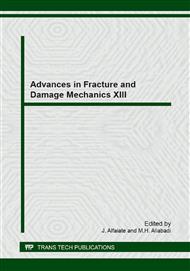p.49
p.53
p.57
p.61
p.65
p.69
p.73
p.77
p.81
High Magnification Studies of Fatigue Crack Propagation
Abstract:
This work presents a set of experiments devoted to studying the crack initiation stage under different combined tension-compression and torsion loads. Two different load levels were applied, producing very different fatigue lives. Lower strains generated lives approximately 10 times longer than higher strains. Results allowed retardation and acceleration effects due to microstructure to be clearly visualised.
Info:
Periodical:
Pages:
65-68
Citation:
Online since:
September 2014
Price:
Сopyright:
© 2015 Trans Tech Publications Ltd. All Rights Reserved
Share:
Citation:


